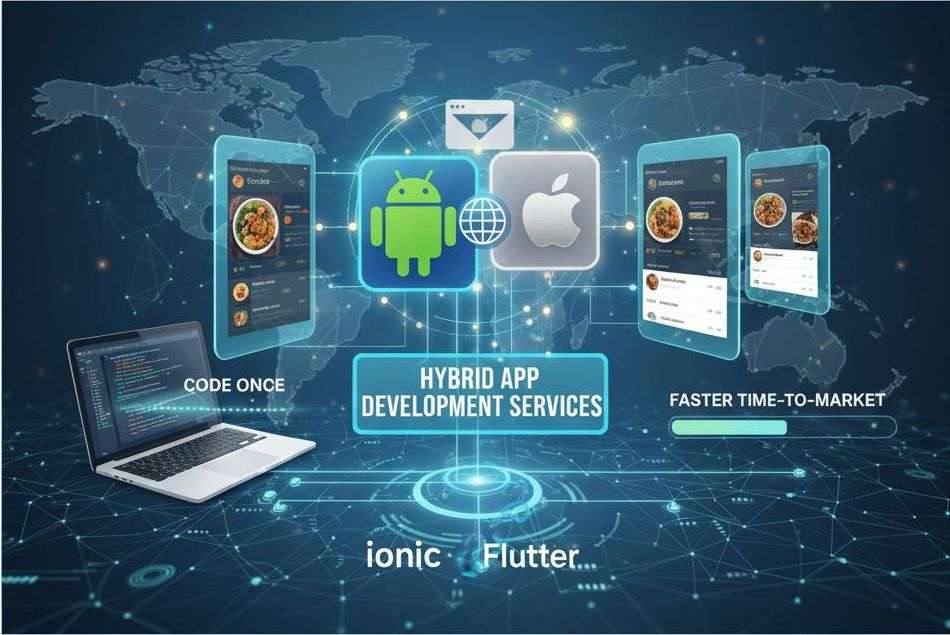A Guide to Hybrid Mobile App Development

- By Mehta Websolution
- Publish Date: 10/01/2025
In today's digital era, mobile applications are essential parts of our daily routines, from finance to food ordering. But developing a high-quality app for both Android and iOS can be complex and expensive. This is why Hybrid Mobile Application Development Services are the industry's go-to solution they offer a highly cost-effective and efficient way to bridge the platform gap.
Ready to discover how to maximize your market reach while minimizing your budget? This guide covers the advantages, core features and practices of this dynamic domain.
5 Major Advantages of Hybrid App Development Services
Choosing hybrid development is a strategic move that delivers clear business benefits:
1. Superior Cost-Effectiveness: A single codebase requires fewer resources and less development time compared to building separate native apps, resulting in significant cost savings.
2. True Cross-Platform Compatibility: Hybrid apps run seamlessly across all major platforms, ensuring a consistent user experience on every device without compromising on functionality or design.
3. Faster Time-to-Market (TTM): Streamlining the development process gets your application to users quicker. This swiftness and adaptability are vital for maintaining a competitive edge.
4. Access to Native Features: Through powerful plug-ins, hybrid apps can integrate device-specific APIs and functions like the camera, geolocation and push notifications, ensuring native-level performance and functionality.
5. Simplified Maintenance: With only one codebase to manage, implementing updates,
security patches and bug fixes is far more efficient and easily deployed across all platforms, reducing maintenance overhead.
Key Features Delivered by Hybrid App Development Services
Top-tier hybrid services deliver features designed for long-term success:
Unified Development Environment: A single environment allows developers to build and deploy across iOS Android and web seamlessly.
Native-Like User Interface (UI): Frameworks like React Native and Ionic ensure hybrid apps provide a polished, native-like user experience by utilizing platform-specific components.
Robust Offline Functionality: Apps can work offline by caching data locally and syncing with the server when a connection becomes available. This ensures seamless access to vital content, enhancing user interaction.
Scalability and Performance: Services use the latest best practices to ensure your app is highly scalable, performant and capable of handling large user bases and heavy workloads.
Integrated Analytics & Reporting: Easy integration with platforms like Google Analytics and Firebase allows for tracking user behavior, gathering crucial insights and continuously optimizing app performance.
Best Practices for Hybrid Mobile App Development Success
Building a hybrid app is an investment. To ensure that investment yields maximum returns, top-tier Hybrid Mobile Application Development Services adhere to these critical best practices:
I. Focus on the User and Performance
Prioritize Seamless User Experience (UX): Deliver an intuitive and consistent UX across all platforms. Adhere to platform-specific design guidelines and leverage native UI components where necessary to achieve a native-like feel.
Optimize for Peak Performance: Performance is non-negotiable. Employ techniques like code splitting, lazy loading and image optimization to guarantee fast load times and smooth, lag-free navigation, keeping users engaged.
Enhance Accessibility & Customization: Ensure your app is accessible to users with disabilities (e.g., semantic HTML, alternative text). Implement customization and personalization features to cater to unique user preferences, boosting engagement and retention.
II. Robust Development and Quality Assurance
Testing is Essential (Test, Test, Test): Thoroughly test your app across diverse devices, screen sizes and operating systems to catch all compatibility issues and bugs before launch. Use automated testing tools and emulators to streamline this critical process.
Implement Strong Security Measures: Protect user data by implementing robust security features, including data encryption and secure authentication methods, ensuring full compliance with regulations like GDPR and CCPA.
Leverage Offline Capability: Integrate offline storage and syncing capabilities. By caching data locally, your app remains functional even with limited or no internet connectivity, providing a continuous user experience.
III. Scalability and Future-Proofing Strategy
Integrate Smartly with Third Parties: Seamlessly integrate with external services and APIs (e.g., payment gateways, analytics tools like Google Analytics) to enhance functionality and drive positive business outcomes.
Adopt Iterative Development & CI/CD: Emphasize collecting user feedback and incorporating it through iterative updates. Implement CI/CD pipelines (Continuous Integration/Continuous Deployment) to automate the build, test and deployment process for faster, more reliable releases.
Ensure Scalability and Future-Proofing: Design the app with a modular architecture and conduct rigorous scalability testing. This ensures your app can effortlessly handle increasing user demands and adapt to evolving technological and business requirements.
Stay Updated: Maintain a competitive edge by keeping abreast of the latest framework updates, industry trends and development best practices.
Conclusion:
Hybrid Mobile Application Development Services are a highly cost-effective, efficient and scalable solution for building powerful cross-platform mobile apps. By combining the best of web technologies with native device features, hybrid apps deliver a seamless user experience while reducing both development time and cost.
With a strategic approach, adherence to these critical best practices and a relentless focus on the end-user, businesses can fully unlock the potential of hybrid mobile app development and stay ahead in today's mobile-first world.
